Morpeth, Northumberland
Morpeth is a historic market town in Northumberland, North East England, lying on the River Wansbeck. Nearby towns include Ashington and Bedlington. In the 2011 census, the population of Morpeth was given as 14,017,[1] up from 13,833 in the 2001 census.[2] The earliest record of the town is believed to be from the Neolithic period. The meaning of the town's name is uncertain, but it may refer to its position on the road to Scotland and a murder which occurred on that road. An alternative origin is a derivation of 'murderers' path' from the time when the gallows were on the Common. The de Marley family was granted the Barony of Morpeth in c. 1080 and built two castles in the town in the late 11th century and the 13th century. The town was granted its coat of arms in 1552. By the mid 1700s it had become one of the main markets in England, having been granted a market charter in 1199, but the opening of the railways in the 1800s led the market to decline. The town's history is celebrated in the annual Northumbrian Gathering.
| Morpeth | |
|---|---|
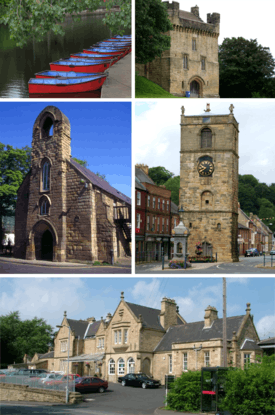  Clockwise from top: River Wansbeck at Carlisle Park, Morpeth Castle, Morpeth Clock Tower, Morpeth station and Morpeth Chantry | |
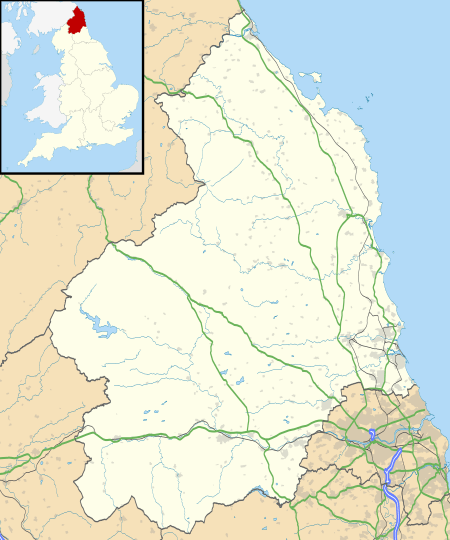 Morpeth Location within Northumberland | |
| Population | 14,017 (2011)[1] |
| Language | English |
| OS grid reference | NZ2085 |
| • Edinburgh | 80 mi (130 km) NW |
| • London | 261 mi (420 km) SSE |
| Civil parish |
|
| Unitary authority | |
| Ceremonial county | |
| Region | |
| Country | England |
| Sovereign state | United Kingdom |
| Post town | MORPETH |
| Postcode district | NE61, NE65 |
| Dialling code | 01670 |
| Police | Northumbria |
| Fire | Northumberland |
| Ambulance | North East |
| UK Parliament | |
Morpeth is governed by Northumberland County Council and Morpeth Town Council. The town is split into three wards – North, Kirkhill and Stobhill – for the purposes of parish elections. In 2008 the town suffered a severe flood, which was repeated in 2012, resulting in the construction of new flood defences. Morpeth railway station is on the east coast line and a curve to the south of it has caused several rail crashes. Several sports teams compete in Morpeth, with Morpeth Town A.F.C. having been the winner of the FA Vase in 2016. The town hosted its own Olympics from 1873 to 1958. Two middle schools, a high school and seven first schools are situated in Morpeth, as well as several churches of Anglican, Roman Catholic, United Reformed and Methodist denominations. Morpeth's Carlisle Park, the recipient of several awards, contains one of the four floral clocks in England.
History
Morpeth was founded at a crossing point of the River Wansbeck.[3] Remains from prehistory are scarce, but the earliest evidence of occupation found is a stone axe thought to be from the Neolithic period. There is a lack of evidence of activity during the Roman occupation of Britain, although there were probably settlements in the area at that time.[3] Morpeth is recorded in the Assize Rolls of Northumberland of 1256 as Morpath and Morthpath,[4] and was also archaically spelt Morepath.[5] The meaning of the town's name is uncertain; "moor path" has been suggested in reference to its historical position on the main road from England to Scotland,[6][7][8] with the marshes around the modern-day Carlisle Park having been suggested to be the "moor" in question.[8] Another possible meaning is that the name derives from the Old English pre-7th-century compound morð-pæð or Morthpaeth, meaning "murder path", in remembrance of "some forgotten" slaying on the road,[9][10][11][12] although some old documents suggest that this meaning is a fallacy.[8]
The barony of Morpeth was granted to the de Merlay family in around 1080, and by 1095 a motte-and-bailey castle had been built by William de Merlay.[3][13][14] Newminster Abbey, located on the outskirts of Morpeth, was founded in 1138 by William's son, Ranulf de Merlay, lord of Morpeth, and his wife, Juliana, daughter of Gospatric II, Earl of Lothian, as one of the first daughter houses of Fountains Abbey.[15][16][17] King John granted a market charter for the town to Roger de Merlay in 1199.[18] It became one of the main markets in Northern England by the mid 1700s and by the mid 18th century was one of the key cattle markets in England;[7][3] however, the opening of the railways made transport to Newcastle easier in the 19th century, and the market accordingly declined.[3] The market is still held on Wednesdays.[19][20][21]

The town was badly damaged by fire set by the barons in 1215 during the First Barons' War, in an attempt to block the military operations of King John.[7] The motte-and-bailey castle was burnt down by King John in 1216.[13][14] Morpeth Castle was built later in the 13th century by Ranulph de Merlay, to the south of Haw Hill.[7][13][14] Also in the 13th century, a stone bridge was built over the Wansbeck in Morpeth,[22] to the west of the current bridge, replacing the ford previously in use in Morpeth.[3][23] For some months in 1515–16, Margaret Tudor (Henry VIII's sister) who was the Queen Consort of Scotland (James IV's widow), had laid ill in Morpeth Castle, having been brought there from Harbottle Castle.[24][25][26] The only remains of the castle are the gatehouse, which was restored by the Landmark Trust, and parts of the ruined castle walls.[27][28]
In 1540, Morpeth was described by the royal antiquary John Leland as "long and metely well-builded, with low houses" and "a far fairer town than Alnwick". During the 1543–51 war of the Rough Wooing, Morpeth was occupied by a garrison of Italian mercenaries, who "pestered such a little street standing in the highway" by killing deer and withholding payment for food.[29] In 1552, William Hervey, Norroy King of Arms, granted the borough of Morpeth a coat of arms. The arms were the same as those granted to Roger de Merlay, but with the addition of a gold tower. In the letters patent, Hervey noted that he had included the arms of the "noble and valyaunt knyght ... for a p'petuall memory of his good will and benevolence towardes the said towne".[30]
Morpeth was a borough by prescription, but received its first charter of confirmation from Charles II. The corporation it created was controlled by seven companies: the Merchant Tailors, the Tanners, the Fullers and Dyers, the Smiths, the Cordwainers, the Weavers and the Butchers.[7] This remained the governing charter until the borough was reformed by the Municipal Corporations Act 1835.[31][32] During the Second World War, RAF Morpeth, an air-gunnery training school, opened at nearby Tranwell.[33][34][35]
The town and the county's history and culture are celebrated at the annual Northumbrian Gathering.[36] The gathering is held over a weekend in mid-April and includes the Border Cavalcade and Pageant.[37][37][38][39] The 50th gathering took place in 2017.[40][41]
Governance
Morpeth has two tiers of local government.
The lower tier is Morpeth Town Council, which has 15 members. Morpeth is a civil parish[42] with the status of a town.[43] For the purposes of parish elections the town is divided into three wards: North, Kirkhill and Stobhill, each returning five town councillors. Each ward also elects one County Councillor. Since May 2017, the political make up of the Town Council has been nine Conservatives, five Liberal Democrats and one Green member.[44][45]
The upper tier of local government is Northumberland County Council, which meets at County Hall in Morpeth.[46][47] Since April 2009 the county council has been a unitary authority.[48] Previous to this there was an intermediate tier, the non-metropolitan district of Castle Morpeth, which has been abolished along with all other districts in the county.[49][50] The county council has 67 councillors,[51][52] of whom three represent Morpeth, one each from the electoral wards of Morpeth Kirkhill, Morpeth North and Morpeth Stobhill.[53] Since the 2017 County Council elections, all three wards have been represented by Conservative councillors.[54]
Climate
Cockle Park, located slightly north of Morpeth, contains a Met Office weather station, founded in 1897.[55][56] The following table shows the climate data of the station from 1971–2000, recorded at 95 metres (312 ft) elevation:
| Climate data for Morpeth, Cockle Park | |||||||||||||
|---|---|---|---|---|---|---|---|---|---|---|---|---|---|
| Month | Jan | Feb | Mar | Apr | May | Jun | Jul | Aug | Sep | Oct | Nov | Dec | Year |
| Record high °C (°F) | 13.8 (56.8) |
15.6 (60.1) |
20.0 (68.0) |
22.1 (71.8) |
24.1 (75.4) |
27.8 (82.0) |
29.6 (85.3) |
32.6 (90.7) |
25.1 (77.2) |
21.7 (71.1) |
17.2 (63.0) |
14.6 (58.3) |
32.6 (90.7) |
| Average high °C (°F) | 6.0 (42.8) |
6.3 (43.3) |
8.4 (47.1) |
10.2 (50.4) |
13.2 (55.8) |
16.1 (61.0) |
18.7 (65.7) |
18.6 (65.5) |
15.7 (60.3) |
12.3 (54.1) |
8.4 (47.1) |
6.7 (44.1) |
11.7 (53.1) |
| Average low °C (°F) | 0.7 (33.3) |
1.0 (33.8) |
2.0 (35.6) |
3.1 (37.6) |
5.5 (41.9) |
8.2 (46.8) |
10.3 (50.5) |
10.4 (50.7) |
8.6 (47.5) |
6.1 (43.0) |
3.1 (37.6) |
1.5 (34.7) |
5.0 (41.1) |
| Record low °C (°F) | −12.0 (10.4) |
−12.8 (9.0) |
−8.9 (16.0) |
−6.1 (21.0) |
−2.7 (27.1) |
0.1 (32.2) |
3.3 (37.9) |
2.8 (37.0) |
0.0 (32.0) |
−2.4 (27.7) |
−9 (16) |
−11.6 (11.1) |
−12.8 (9.0) |
| Average precipitation mm (inches) | 59.77 (2.35) |
45.51 (1.79) |
55.15 (2.17) |
51.03 (2.01) |
54.03 (2.13) |
53.53 (2.11) |
51.63 (2.03) |
66.34 (2.61) |
62.04 (2.44) |
58.23 (2.29) |
69.75 (2.75) |
66.68 (2.63) |
693.69 (27.31) |
| Source: Royal Dutch Meteorological Institute/KNMI[57] | |||||||||||||
2008 and 2012 floods
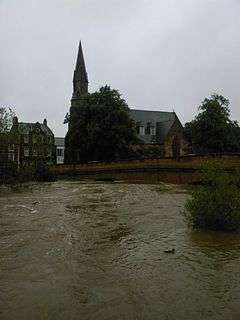
On 6 September 2008, Morpeth suffered a severe flood,[58][59] causing damage to 1,000 properties and leading 400 residents to be evacuated.[60][61][62] The town's flood defences were breached after 12 hours, when a month's worth of rain fell on Morpeth.[62][59]
In September 2012, flooding occurred again, causing damage to properties, although floodwaters were reportedly 3 feet (1 m) shallower than in 2008.[63]
Flood defences
Work on flood defences started in 2013 in response to the 2008 floods. New flood defences were built in the town centre and a dam with a storage reservoir was built on the Mitford Estate.[64] A second £27m dam was completed in May 2017 to reduce flooding from the Cotting Burn and marked the completion of the Morpeth flood defence plan.[65][66]
Transport
The A1, the longest numbered road in the UK, used to pass through Morpeth until the bypass was opened in 1970.[67] Morpeth's railway station is on the main East Coast Main Line which runs between London and Edinburgh. To the south of the station is a sharp curve which has been the scene of several train crashes.[68][69] A non-passenger line operates between Morpeth and Bedlington.[70] A former line, closed in 1966, ran west from Morpeth to Scots Gap (from where there was a branch line to Rothbury),[71][72] then west to Redesmouth,[72] and lastly south to Hexham.[73]
Education
The local state school, King Edward VI School, was originally founded as a chantry school in the early 14th century and was located in the Morpeth Chantry.[3] The school was refounded in 1552 by royal charter as the Free Grammar School of King Edward the Sixth,[74] being commonly referred to as the Morpeth Grammar School by locals.[75] The school was renamed to King Edward VI Grammar School by 1947[76] and in the 1970s lost its grammar school status, becoming a comprehensive under the current name.[77]
The town has two middle schools, Newminster and Chantry, which are built next door to one another.[78] It also has several first schools: Abbeyfields First School in Kirkhill, Morpeth First School in Goose Hill (and relocating for the start of the 2019 school year), Stobhillgate First School in the Stobhillgate housing estate, and Morpeth All Saints' Church of England-aided First School in Lancaster Park, which is located north of the town.[79] Additionally, St. Robert's R.C. First School, a primary school for Roman Catholics, is located in Oldgate, Morpeth.[80]
Religious sites
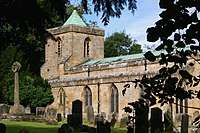
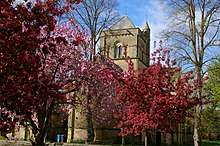
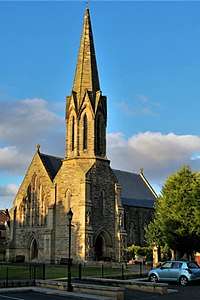
Church of England
The ancient Church of England parish church of Morpeth is St Mary's at High Church,[81] which was the main Anglican place of worship in the area until the 1840s.[82] The church is mostly in the 14th century style.[83][84][85][82] The grave of Emily Wilding Davison lies in St Mary's graveyard.[86][87][88]
In 1843, a public meeting was called to address the lack of attendance at the church, and it was found that the walk to the current church, on the southern edge of the town, was too much for many of the parishioners.[89][90][91] From this meeting, it was decided to build a new church in the town centre[90][91] and accordingly, the church of St James the Great was consecrated for worship on 15 October 1846.[92][93] Benjamin Ferrey designed the church in a "Neo-Norman" style,[93][91] based on the 12th century Monreale Cathedral, Sicily.[94][95]
A third parish church, St Aidan's, was founded as a mission church in 1957, located on the Stobhill estate on the south-east of the town.[96][97][98]
Roman Catholic Church
Morpeth's Roman Catholic Church, dedicated to St Robert of Newminster, was built off Oldgate on land adjacent to Admiral Lord Collingwood's house. It opened on 1 August 1850 and was consecrated by the Right Reverend, William Hogarth, Bishop of Samosata (later Bishop of Hexham).[99][100][101] Collingwood House is now the presbytery (residence) for the priest in charge of the Church.[102]
United Reformed Church
Morpeth has had a Presbyterian ministry since 1693. Their first service was held in a tannery loft in the town in February 1693 and in 1721 a chapel was built in Cottingwood Lane,[103] which still exists as a private home. The construction of St. George's United Reformed Church began in 1858 and the first service in the new building was held on 12 April 1860.[104] The Church stands immediately to the north of the Telford Bridge[105] and is in the style of the early English era, containing a stained glass rose window and an octagonal spirelet.[106]
Methodist Church
The present Methodist Church in Howard Terrace was opened as a Primitive Methodist place of worship on 24 April 1905.[107] Designed by J. Walton Taylor, it was built from local quarry stone. Although the Primitive Methodists were united with the Wesleyan Church to form the Methodist Church of Great Britain in 1932,[108] a separate Wesleyan Church continued to function in Manchester Street until 1964, when the congregations were united at Howard Terrace.[109] The former Wesleyan Church (built in 1883) is currently used as the Boys' Brigade headquarters.[110][111]
Sport
Morpeth Town A.F.C.,[112][113] Morpeth RFC[114][115] and the Morpeth Golf Club[116][117] play competitively within Morpeth. In addition, the Morpeth Harriers compete in athletics.[118][119] The town also offers opportunities to play sport on a non-competitive basis through facilities such as Carlisle Park,[120] the common for playing golf and football,[121] and the Riverside leisure centre for swimming, indoor sports and fitness gym activities.[122][123] Morpeth Town A.F.C. was the 2016 winner of the FA Vase.[112]
The Morpeth Olympic Games, a professional event consisting mainly of athletics and wrestling, were staged from 1873 until 1958, barring interruptions during the two world wars. The Games were held on the Old Brewery Field until 1896, then at Grange House Field until the First World War. After two years at the town's cricket pitch at Stobhill (1919–20), the Olympics moved to Mount Haggs Field until 1939, and then back to Grange House Field after the war until the end of the games in 1958.[124][125]
In 1730, a racecourse was built for horse racing, which was used until 1854, when the racetrack was replaced with St. George's Hospital.[59][126][127]
The town was the start point of the Morpeth To Newcastle Road Race. It was held annually on New Year's Day from 1902 to 2004, when insurance and policing costs became prohibitively high, and winners included Commonwealth champion Jack Holden and Olympic medallist Mike McLeod.[128][129]
Landmarks
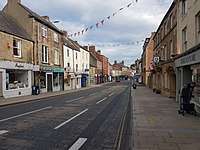
The historical layout of central Morpeth consisted of Bridge Street, Oldgate Street and Newgate Street, with burgage plots leading off them. Traces of this layout remain: Old Bakehouse Yard off Newgate Street is a former burgage plot, as is Pretoria Avenue, off Oldgate.[130] The town stands directly on what used to be the Great North Road, the old coaching route between London and Edinburgh.[131]
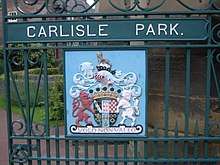
.jpg)
Carlisle Park is located on the southern bank of the River Wansbeck in Morpeth.[132] The park has the William Turner Garden,[133][134] one of the only four floral clocks in England,[135] a statue of Emily Wilding Davison,[136][137] as well as other facilities and attractions.[132][138][120] Morpeth's Mafeking Park, at the bottom of Station Bank, was unsuccessfully put forward by locals to be listed as the smallest park in the world in the Guinness Book of Records.[139]
Other landmarks are:
- Morpeth Clock Tower, a free-standing 17th century clock tower[59]
- A grand town hall, originally designed by Sir John Vanbrugh (rebuilt 1869)[59]
- Collingwood House, the Georgian home of Admiral Lord Collingwood[102]
- Morpeth Chantry, a 13th-century chapel that now houses the town's tourist information centre and the Morpeth Chantry Bagpipe Museum[140]
- Morpeth Castle, which stands on a hill to the south, is now operated by the Landmark Trust as holiday accommodation[141]
- A nuclear bunker located underneath Morpeth County Hall[59]
- A gateway on High Stanners framed by a whale's jawbone[142]
- Ruins of Newminster Abbey, a former Cistercian abbey about one mile to the west of Morpeth[143][144]
Notable people
- Lawrence William Adamson (1829–1911), High Sheriff of Northumberland, who died at Linden Hall near Morpeth in 1911[145]
- James (Jim) Alder MBE (born 1940), athlete, who spent his childhood in Morpeth after being adopted by Adler family[146][147]
- Emerson Muschamp Bainbridge (1817–1892), founder of Bainbridge Department Store – the first such store in the world – in Newcastle upon Tyne, who, from 1877, lived near Morpeth at Eshott Hall[148]
- Arthur Bigge, 1st Baron Stamfordham (1849–1931), born at Linden Hall, near Morpeth, who became private secretary to Queen Victoria and George V[149]
- Robert Blakey (1795–1878), radical journalist and philosopher, born in Manchester Street, Morpeth[150]
- Luke Clennell (1781–1840), engraver and painter, born in Morpeth[151]
- Vice Admiral Cuthbert Collingwood (1748–1810), Royal Navy Admiral. He lived at Collingwood House in Oldgate and once said "Whenever I think how I am to be happy again, my thoughts carry me back to Morpeth".[152][153]
- Emily Wilding Davison, a suffragette who was killed when she fell under the King's horse during the Epsom Derby in 1913.[154] Following her funeral in London, her coffin was brought by train to Morpeth for burial in St Mary's churchyard.[88][86][87]
- William Elliott, Baron Elliott of Morpeth (1920–2011), Conservative politician born in Morpeth[155]
- Toby Flood (born 1985), rugby union player for Leicester Tigers and England, who attended Morpeth Chantry School[156]
- John Cuthbert Hedley (1837–1913), Benedictine monk and Roman Catholic Bishop of Newport born at Carlisle House, Morpeth[157]
- Charles Howard, 3rd Earl of Carlisle (1669–1738), MP for Morpeth in 1689–1692[158]
- Edward Knott (1581–1656), Jesuit, born in Pegswood, near Morpeth[159]
- Robert Morrison (1782–1834), translator of the Bible into Chinese and first Protestant missionary in China, born in Buller's Green, Morpeth[160]
- John Peacock (c.1756–1817), piper, born in Morpeth[161][162]
- John Urpeth Rastrick (1780–1856), railway engineer, born in Morpeth[163]
- Joe Robinson (1919–1991), footballer, born in Morpeth, who played for Blackpool in the 1948 FA Cup Final[164][165]
- Walter Trevelyan MA (1821 – 1894), first-class cricketer and barrister, born in Morpeth[166]
- William Turner (naturalist) MA (c. 1508 – 13 July 1568), an English divine and reformer, physician and natural historian.[167] The William Turner Garden is situated in Carlisle Park, Morpeth.[133][134]
- The Right Reverend Dr. N. T. Wright (born 1948), Anglican theologian and author, born in Morpeth[168][169]
See also
- Viscount Morpeth, the heir apparent to the Earl of Carlisle.
References
- UK Census (2011). "Local Area Report – Morpeth Parish (1170219946)". Nomis. Office for National Statistics. Retrieved 21 March 2018.
- UK Census (2001). "Local Area Report – Morpeth Parish (1543510106)". Nomis. Office for National Statistics. Retrieved 9 November 2018.
- "Local History for Morpeth (Northumberland), Ref No N13457". Keys to the Past. Archived from the original on 3 December 2007. Retrieved 6 March 2019.
- "Three Early Assize Rolls for the County of Northumberland". Publications of the Surtees Society. Surtees Society. 88: 473. 1891. Retrieved 21 May 2018.
- Hare, Augustus John Cuthbert (1873). A Handbook for Travellers in Durham and Northumberland. John Murray. pp. 185–186. Retrieved 21 May 2018.
- Harper, Charles George (1902). The Great North Road: The Old Mail Road to Scotland. 2. Chapman & Hall. p. 172.
- "Morley - Morton-upon-Lug: Morpeth (St. Mary)". A Topographical Dictionary of England. British History Online. London: Samuel Lewis. 1848. pp. 345–350. Archived from the original on 1 December 2018. Retrieved 5 March 2019.
- "What's in a name? It could be misleading". Morpeth Herald. Retrieved 25 June 2017.
- "Did murder pave the way for town's unusual name?". Morpeth Herald. 17 July 2012. Archived from the original on 6 February 2016. Retrieved 21 May 2018.
- Hanks, Patrick; Hodges, Flavia; Mills, A. D.; Room, Adrian (2002). The Oxford Names Companion. Oxford: the University Press. p. 438. ISBN 978-0198605614.
- Mawer, Allen (1920). The Place-Names of Northumberland and Durham. Forgotten Books (originally Cambridge University Press). p. 143. ISBN 9781332178568.
- Kelly, Mike (5 October 2016). "Find out how North East villages, towns and cities got their names". Chronicle Live. Retrieved 8 November 2018.
- Historic England (26 January 2000). "Motte and bailey castle on Haw Hill (1017376)". National Heritage List for England. Retrieved 14 November 2018.
- "Haw Hill (Morpeth)". Keys To The Past. 4 November 2016.
- "Cistercian Abbeys: NEWMINSTER". The Cistercians in Yorkshire. Sheffield University. Retrieved 10 November 2009.
- The English Baronetage Containing a Genealogical and Historical Account of All the English Baronets. 1. 1741. p. 301.
- Henderson, Tony (5 July 2016). "New book explores a young girl's journey to Morpeth and an arranged marriage". Chronicle Live.
- Gavin, Greg (15 June 2018). "Northumberland Markets Strategy 2018 – 2022" (PDF). Northumberland County Council. p. 12.
- "Morpeth Markets" (PDF). Sanderson Arcade. 2015.
- Hall, Jane (28 June 2017). "Why Morpeth's monthly farmers' market will be catering to those with a sweet tooth". Chronicle Live.
- Daniel, Brian (15 April 2008). "County town row grows". The Journal. Retrieved 27 January 2019.
- Historic England. "Morpeth Old Bridge: 1020744 (1020744)". National Heritage List for England. Retrieved 2 December 2018.
- "Crossing the Wansbeck". Morpeth Herald. 2 September 2012. Retrieved 2 December 2018.
- "Morpeth in the Middle Ages – and a Royal visitor calls". Morpeth Herald. 21 July 2013. Retrieved 9 November 2018.
- McCabe, Stuart (9 May 2016). Queen Margaret Tudor: The Story of a Courageous but Forgotten Monarch. Mereo Books. p. 79. ISBN 9781861516145.
- Weir, Alison (25 February 2016). The Lost Tudor Princess: A Life of Margaret Douglas, Countess of Lennox. Random House. p. 12. ISBN 9780099546467.
- Historic England. "Morpeth Castle (1155642)". National Heritage List for England. Retrieved 9 November 2018.
- "Morpeth Castle: Restoration". The Landmark Trust.
- 12th Report & Appendix, Duke of Rutland. 1. Historical Manuscripts Commission. 1888. pp. 44–45.
- Fox-Davies, A. C. (1915). The Book of Public Arms (2 ed.). London: T.C. & E.C. Jack. p. 526.
- The Parliamentary Gazetteer of England and Wales. 3. A. Fullarton and Company. 1847. p. 449.
- "A hole lot of history about meeting place". Morpeth Herald. 13 October 2015. Retrieved 2 December 2018.
- "RAF Morpeth - Regiment History, War & Military Records & Archives". Forces War Records.
- "The flyers who never lived to see their homeland free again". Morpeth Herald. 7 March 2002.
- Johnson, George Johnny (4 June 2015). The Last British Dambuster: One Man's Extraordinary Life and the Raid That Changed History. Random House. p. 92. ISBN 9780091957759.
- "Morpeth Northumbrian Gathering". Northumbriana.
- "A special gathering at Morpeth". Northumberland Gazette. 25 April 2014. Retrieved 6 December 2018.
- Black, David (13 April 2012). "Morpeth's Olympics links recalled at Northumbrian Gathering". The Journal.
- "Abundance of characters in Gathering pageant". Morpeth Herald. 20 April 2015.
- "Morpeth is all set for a golden Gathering". Morpeth Herald. 15 April 2017. Retrieved 3 December 2018.
- "Barn dance to bring to an end golden year celebrations". Morpeth Herald. 16 November 2017. Retrieved 3 December 2018.
- "Northumberland Parish Map (Morpeth is 113)" (PDF). Northumberland County Council.
- "Statistical Profiles and Census Fact Sheets: Northumberland Towns". Northumberland County Council.
- "Councillors". Morpeth Town Council. Retrieved 12 October 2018.:
- "North Ward Councillors". Morpeth Town Council. Retrieved 7 November 2018.
- "Kirkhill Ward Councillors". Morpeth Town Council. Retrieved 7 November 2018.
- "Stobhill Ward Councillors". Morpeth Town Council. Retrieved 7 November 2018.
- Kelly, Mike; Muncaster, Michael (5 May 2017). "Northumberland local elections results IN FULL - council held by Tories in 'straw draw' drama". Chronicle Live. Retrieved 19 January 2019.
- Muncaster, Michael (18 January 2018). "The £17m vision for Northumberland County Hall is unveiled - which you'll be paying for". Chronicle Live.
- "Cancelled Northumberland County Council HQ move cost £5.5m". Hexham Courant. 6 June 2018.
- "Green light for five flagship Unitary Councils". communities.gov.uk. Northumberland County Council. 5 December 2007. Archived from the original on 7 January 2018.
- "District councils to be abolished". BBC News. 25 July 2007.
- "The Northumberland (Structural Change) Order 2008: Section 4", legislation.gov.uk, The National Archives, SI 2008/494 (s. 4)
- "Local elections Results". Northumberland County Council. 5 May 2017.
- "County councillor information". Northumberland County Council.
- "Councillors". Morpeth Town Council. Retrieved 12 October 2018.
- "Northumberland County Election Results 2017". Northumberland County Council. Retrieved 5 May 2017.
- "UK Surface Data - Detailed List of Met Office surface stations". Archived from the original on 29 January 2018.
- "UK climate - Synoptic and climate stations". MET Office.
- "Morpeth Climate". KNMI. Archived from the original on 23 February 2013. Retrieved 7 November 2011.
- Mr. Denis Murphy (23 October 2008). "Flooding (Morpeth)". Parliamentary Debates (Hansard). Parliament of the United Kingdom. col. 535–536. Retrieved 7 November 2018.
- "Ten interesting facts about Morpeth". Evening Chronicle. 1 January 2012. Retrieved 8 November 2018.
- Weaver, Matthew; Wainwright, Martin (8 September 2008). "Flood damage to cost 'tens of millions'". The Guardian. Retrieved 7 November 2018.
- "Heavy rainfall early September 2008". The MET Office. 29 October 2012. Retrieved 7 November 2018.
- "Morpeth a 'scene of devastation'". BBC News. 7 September 2008. Retrieved 13 May 2010.
- "Morpeth: Anger over second flood in four years". BBC News. 26 September 2012.
- "Why did flood defences in Morpeth hold out while those in Corbridge failed?". Evening Chronicle. 6 January 2016. Retrieved 12 October 2018.
- "Work on £27m Morpeth flood defence scheme has been completed". Evening Chronicle. 20 July 2017. Retrieved 12 October 2018.
- "Final part of Morpeth's multi-million flood defences are complete". ITV News. 21 July 2017. Retrieved 12 October 2018.
- Maddison, J.D. "A1 Morpeth Bypass northeastern cutting slope failure, preventative maintenance". ICE Virtual Library. ICE Publishing. doi:10.1680/ecsmge.60678.vol4.230 (inactive 24 March 2020).
- "Tracking the history of town's railway". Morpeth Herald. 31 October 2017.
- David Mitchell, The Parliamentary Under-Secretary of State for Transport (25 June 1984). "Railway Accident (Morpeth)". Parliamentary Debates (Hansard). 62. House of Commons. col. 688–688.
- "Rail freight assessment" (PDF). Tyne and Wear Freight Partnership. April 2009. p. 13.
- Morton, David (14 August 2013). "Remember When: Battle to bring railway to Morpeth". Chronicle Live.
- Henderson, Tony (2 June 2010). "Wannie Line celebrated in exhibition at Bellingham". The Journal. Retrieved 24 November 2018.
- "Rail historian recalls the old Rothbury line". Northumberland Gazette. 14 April 2005. Retrieved 24 November 2018.
- Kennedy, G. (November 1951). The Story of Morpeth Grammar School (1 ed.). The Old Boy's Association. p. 19.
- Kennedy, G. (November 1951). The Story of Morpeth Grammar School (1 ed.). The Old Boy's Association. p. 22.
- "Morpeth historian dies at 81". Morpeth Herald. 22 November 2001.
- "Friends from the school yard to 50". Morpeth Herald. 6 October 2010.
- Daniel, Brian (13 January 2014). "Fears for safety of Morpeth schoolchildren as pupils cross busy road unaided". The Journal.
- These references are in order of their mention in the article:
- "Morpeth Newminster Middle School". compare-school-performance.service.gov.uk. Retrieved 9 November 2018.
- "Morpeth Chantry Middle School". compare-school-performance.service.gov.uk. Retrieved 9 November 2018.
- "Abbeyfields First School". compare-school-performance.service.gov.uk. Retrieved 9 November 2018.
- "Morpeth First School". compare-school-performance.service.gov.uk. Retrieved 9 November 2018.
- "Morpeth Stobhillgate First School". compare-school-performance.service.gov.uk. Retrieved 9 November 2018.
- "Morpeth All Saints Church of England Aided First School". compare-school-performance.service.gov.uk. Retrieved 9 November 2018.
- "St Robert's Roman Catholic Voluntary Aided First School". compare-school-performance.service.gov.uk. Retrieved 9 November 2018.
- "Morpeth: Northumberland Extensive Urban Survey" (PDF). Northumberland County Council. 2009. p. 25 (section 4.1). Retrieved 10 November 2018. Source supports "High Church", because the church subsection is in the "South of the Wansbeck" section and the nickname for the "South of the Wansbeck" is "High Church" as stated in the source.
- "The Parish Church of St Mary the Virgin". Parish of Morpeth in the Diocese of Newcastle. Retrieved 10 November 2009.
- Hodgson, J. (1832). A History of Northumberland: Part 2. 2. pp. 390–94.
- Historic England. "Church of St Mary (1042763)". National Heritage List for England. Retrieved 24 November 2018.
- "Morpeth: Northumberland Extensive Urban Survey" (PDF). Northumberland County Council. 2009. p. 16 (section 3.2.4). Retrieved 10 November 2018.
- "Miss Davison's Funeral". Votes for Women. 20 June 1913. p. 553.
- Sleight, John (1988). One-way Ticket to Epsom: Journalist's Enquiry into the Heroic Story of Emily Wilding Davison. Morpeth, Northumberland: Bridge Studios. p. 100. ISBN 978-0-9512-6302-0.CS1 maint: ref=harv (link)
- "Miss Davison's Funeral: Impressive London Procession". The Manchester Guardian. 16 June 1913. p. 9.
- "History of St James the Great". Archived from the original on 12 June 2018.
- Turrill, J. (1844). "Events of the Month: Northumberland". The British Magazine and Monthly Register of Religious and Ecclesiastical Information, Parochial History, and Documents Respecting the State of the Poor, Progress of Education. Vol. 26. p. 353, section 'Northumberland'.
- "Anglo-Norman Church Built at Morpeth, Durham". The Builder. Vol. 4 no. 178. 1846. p. 373.
- "Local Events of the Year 1846: October". Local Collections; or Records of Remarkable Events connected with the Borough of Gateshead in 1846. Vol. 8. 1847. p. 119, section 'October' No. 15.
- "Morpeth: Northumberland Extensive Urban Survey" (PDF). Northumberland County Council. 2009. 33 (section 5.5.3). Retrieved 10 November 2018.
- "The Architect: The Church of St James the Great". Retrieved 9 November 2018.
- "The Church of St.James the Great in the Parish of Morpeth". Morpeth Parochial Church Council. 2004. Archived from the original on 10 February 2013. Retrieved 10 November 2009.
- "St Aidan's Church". Parish of Morpeth in the Diocese of Newcastle. Retrieved 10 November 2009.
- "Church plans a new 'beacon'". Morpeth Herald. 13 March 2014. Retrieved 30 November 2018.
- Coulson, Andrew (30 January 2016). "Church revamp proves a big hit". Morpeth Herald. Retrieved 30 November 2018.
- "Local Intelligence - New Catholic Church of St Robert at Morpeth". North & South Shields Gazette and Northumberland and Durham Advertiser. 16 August 1850.
- "Morpeth: Northumberland Extensive Urban Survey" (PDF). Northumberland County Council. 2009. p. 33 (section 5.5.6). Retrieved 10 November 2018.
- Historic England. "Roman Catholic Church of St Robert (1156182)". National Heritage List for England. Retrieved 24 November 2018.
- Historic England. "Collingwood House (1042740)". National Heritage List for England. Retrieved 9 November 2018.
- Historic England. "Kirkville (1042761)". National Heritage List for England. Retrieved 2 December 2018.
- "Our history". St George's United Reformed Church Morpeth. Retrieved 9 November 2018.
- McParlin, Pete (15 August 2011). The Lambton Worm: The Definitive Guide to Angling in North East England. Amberley Publishing Limited. ISBN 9781445625867.
- "St. George's United Reformed Church, Morpeth". St. George's United Reformed Church, Morpeth. Retrieved 10 November 2009.
- "Morpeth: Northumberland Extensive Urban Survey" (PDF). Northumberland County Council. 2009. p. 34 (section 5.5.9). Retrieved 10 November 2018.
- Calder, Sandy (14 December 2017). "The Origins of Primitive Methodism". The English Historical Review. 132 (558): 1351. doi:10.1093/ehr/cex245.
- "History of the Methodist Church in Morpeth". Morpeth Methodist Church. Retrieved 10 November 2009.
- "Fascinating history of the brigade hall". Morpeth Herald. 28 December 2014. Retrieved 13 October 2018.
- "Morpeth: Northumberland Extensive Urban Survey" (PDF). Northumberland County Council. 2009. p. 33 (section 5.5.5). Retrieved 10 November 2018.
- Smith, Alan. "Morpeth come back to win FA Vase and crush Hereford's Wembley dream". The Guardian. Retrieved 7 August 2017.
- Gibson, Sean (22 May 2016). "Morpeth Town's 45-year-old Chris Swailes becomes oldest scorer in a Wembley cup final, two years after 'being killed three times'". The Telegraph.
- "Morpeth juniors bags Land Rover Cup finals spot at Twickenham". Evening Chronicle. 12 December 2013. Retrieved 5 December 2018.
- "Morpeth hoping to be lucky in the Longhirst Sevens". The Journal. 27 April 2011. Retrieved 5 December 2018.
- "Trophies for club's successful juniors". Morpeth Herald. 13 October 2013. Retrieved 5 December 2018.
- "Getting ladies on the greens". Morpeth Herald. 24 May 2014. Retrieved 5 December 2018.
- "Morpeth Harriers in top 50 list". Morpeth Herald. 2 January 2003. Retrieved 9 November 2018.
- Black, David (16 July 2012). "Morpeth Harriers finally get their own synthetic track". The Journal. Retrieved 9 November 2018.
- "Refurbished courts are looking ace". Morpeth Herald. 14 October 2018. Archived from the original on 15 November 2018. Retrieved 15 November 2018.
- "Morpeth Neighbourhood Plan" (PDF). Northumberland County Council. p. 20 section 5.3.4.
- "Morpeth Neighbourhood Plan" (PDF). Northumberland County Council. p. 54 section 9.1.3.
- Daniel, Brian (19 November 2014). "Northumberland County Council unveils multi-million pound spending plans". The Journal.
- "When Morpeth had its very own Olympics". Morpeth Herald. 16 June 2011. Retrieved 10 November 2018.
- Henderson, Tony (30 April 2011). "Sport event to recall Morpeth Olympic Games". The Journal.
- "Race Course (Morpeth)". Keys to the Past. Retrieved 10 November 2018.
- "Morpeth hospital's fascinating history". Morpeth Herald. 18 August 2008. Retrieved 6 March 2019.
- "Longest Running Road Races". Association of Road Racing Statisticians. Retrieved 9 May 2019.
- "Morpeth to Newcastle Half Marathon". Association of Road Racing Statisticians. Retrieved 9 May 2019.
- "Morpeth: Northumberland Extensive Urban Survey" (PDF). Northumberland County Council. 2009. p. 18 - 19 (sections 3.3.2 to 3.3.5). Retrieved 10 November 2018.
- Harper, Charles George (1901). The Great North Road: The Old Mail Road to Scotland. 2. p. 32.
- "Northumberland County Council: Parks & Gardens". Retrieved 1 March 2017.
- Smith, Anna (13 April 2015). "Friendship for a famous son to raise funds and awareness". Morpeth Herald. Archived from the original on 23 November 2018. Retrieved 22 November 2018.
- "Happy birthday to the 'father of botany'". Evening Chronicle. 26 April 2008. Retrieved 22 November 2018.
- "Launch event to mark reinstated floral clock in park". Morpeth Herald. 24 June 2018. Archived from the original on 10 November 2018. Retrieved 9 November 2018.
- Graham, Hannah (11 September 2018). "The story behind the new statue of Morpeth's suffragette hero". Chronicle Live.
- Coltman, Jane (11 November 2018). "GALLERY: New statue honours Morpeth heroine". Northumberland Gazette.
- Duke, Simon (24 June 2018). "When is Morpeth paddling pool open? Outdoor visitor spot set to be popular this summer". Chronicle Live.
- "Park Mafeking South Africa 1899-1902 Station Bank: Memorial Details". North East War Memorials Project. Retrieved 2 December 2018.
- "All Saints Chantry (Morpeth)". Keys To The Past. Archived from the original on 14 March 2007. Retrieved 6 March 2019.
- "Morpeth Castle". Landmark Trust. Retrieved 2 January 2019.
- "Some triumphant and tragic tales of the sea". Morpeth Herald. 3 April 2013.
- "Morpeth: Northumberland Extensive Urban Survey" (PDF). Northumberland County Council. 2009. p. 14. Retrieved 10 November 2018.
- Historic England. "Newminster Abbey (1155952)". National Heritage List for England. Retrieved 10 November 2018.
- Rogerson, Kristina Robyn (May 1990). "Tourist Attractions: Linden Hall". Longhorsley, Past and Present.
- "The Sunday Post's Hon Man gave Scots marathon hero his family back". The Sunday Post. 16 February 2014. Retrieved 22 November 2018.
- Turnball, Simon (11 October 1998). "Athletics: Morpeth's man of steel". The Independent. Retrieved 22 November 2018.
- (subscription required) Anne Pimlott Baker, Bainbridge, Emerson Muschamp (1817–1892) in the Oxford Dictionary of National Biography (Oxford University Press, 2004), accessed 24 April 2008.
- (subscription required) William M. Kuhn, Bigge, Arthur John, Baron Stamfordham (1849–1931) in the Oxford Dictionary of National Biography (Oxford University Press, 2004; online edition, Jan 2008), accessed 24 April 2008.
- Hawkins, Roger. "Blakey, Robert (1795–1878)". Oxford Dictionary of National Biography (online ed.). Oxford University Press. doi:10.1093/ref:odnb/2595. (Subscription or UK public library membership required.)
- Hawkins, Roger (24 June 2017). "Tale of a talented and keen artist ends in tragedy". Morpeth Herald.
- Jackson, Chris (host) (28 February 2005). "BBC Inside Out North East: Collingwood - Forgotten Hero". Inside Out. BBC One.
- "Salute to Morpeth hero". Morpeth Herald. 29 December 2004. Retrieved 13 December 2018.
- Thorpe, Vanessa (26 May 2013). "Truth behind the death of suffragette Emily Davison is finally revealed". The Guardian. Retrieved 24 November 2018.
- "A kind and courteous man". Morpeth Herald. 26 May 2011.
- "Toby Flood England profile". RFU.com. Archived from the original on 7 April 2014. Retrieved 5 October 2009.
- (subscription required) Alban Hood, Hedley, John Cuthbert (1837–1915) in the Oxford Dictionary of National Biography (Oxford University Press, 2004), accessed 24 April 2008.
- Duncan, Andrew I. M. (1981). "A Study of the Life and Public Career of Frederick Howard, Fifth Earl of Carlisle, 1748-1825". University College Oxford. p. 258 (268 through pdf).
- Packer, John William (1969). The Transformation of Anglicanism, 1643-1660: With Special Reference to Henry Hammond. Manchester University Press.
- (subscription required) R. K. Douglas (revised Robert Bickers), Morrison, Robert (1782–1834) in the Oxford Dictionary of National Biography (Oxford University Press, 2004; May 2007 online edition), accessed 23 April 2008.
- Pendlebury, Celia (February 2015). "Jigs, Reels and Hornpipes: A History of "Traditional" Dance Tunes of Britain and Ireland" (PDF). Department of Music, University of Sheffield. p. 152.
- "Northumbrian Piper's Society Magazine" (PDF). northumbrianpipers.org.uk. Vol. 12. Northumbrian Piper's Society. 1991. p. 15. ISSN 0261-5096.
- (subscription required) G. C. Boase (revised M. W. Kirby), Rastrick, John Urpeth (1780–1856) in the Oxford Dictionary of National Biography (Oxford University Press, 2004; Jan 2008 online edition), accessed 23 April 2008.
- "FA Cup medal stolen from Blackpool player's family". BBC News. 15 January 2010.
- "Soccerbase: Joe Robinson". soccerbase.com. Retrieved 22 November 2018.
- Welch, Reginald Courtenay (1957). The Harrow School Register, 1801-1893. Longmans, Green. p. 104. Retrieved 28 March 2019.
- (subscription required) Whitney R. D. Jones, Turner, William (1509/10–1568) in the Oxford Dictionary of National Biography (Oxford University Press, 2004; Jan 2008 online edition), accessed 23 April 2008.
- "Our friend from the North". Northern Echo. 12 February 2003. Retrieved 22 November 2018.
- "Bishop of Durham Dr Tom Wright to retire". The Journal. 28 April 2010. Retrieved 22 November 2018.
External links
